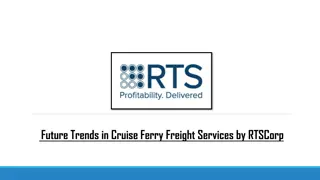Insights into the Cruise Industry Trends
The Cruise Lines Industry Association's 2018 Global Passenger Report shows a significant increase in global cruise passengers, with the Caribbean remaining a top destination. North American cruise passengers, especially from the United States, showed a notable rise. Major cruise lines such as Royal Caribbean, Norwegian Cruise Line, and Carnival reported revenue growth in 2019. Travel agents continue to play a crucial role in cruise bookings. Desirable destinations like the Caribbean and Alaska saw increased cruise visits in 2019, indicating a positive trend in the industry.
Download Presentation

Please find below an Image/Link to download the presentation.
The content on the website is provided AS IS for your information and personal use only. It may not be sold, licensed, or shared on other websites without obtaining consent from the author. Download presentation by click this link. If you encounter any issues during the download, it is possible that the publisher has removed the file from their server.
E N D
Presentation Transcript
Making Waves According to the Cruise Lines Industry Association s (CLIA) 2018 Global Passenger Report, the total worldwide passenger volume of 28.5 million exceeded CLIA s forecast of 28.0 million, and was a 6.7% increase from 2017 s 26.7 million. CLIA has forecasted a global cruise passenger volume of 30.0 million for 2019, which would be a 5.3% increase from 2018. The association also announced its member-cruise lines would launch 18 new ocean ships during 2019. The Caribbean continued its ship deployment dominance, with 34.4% of the 2018 total, a one- percentage point decrease from 2017, but still essentially double second-place Mediterranean s 17.3%, although it increased from 15.8% for 2017.
Americans Like Waterborne Adventures Of those 14.24 million North American cruise passengers in the table above, 13.09 million were from the United States, resulting in a 10% increase, compared to a 5% increase from 2017 s 11.94 million passengers. Unsurprisingly, the most 2018 US cruise passengers were from Florida, 2.2 million (+14.0%); California, 1.37 million (+6.0%); and Texas, 1.1 million (+10.0%). The average 2018 cruise duration remained unchanged from 2016 and 2017, at 6.8 days, and the average age was the same for all three years, or 45.
Cruising on Deep Revenues Despite the negative effect of Hurricane Dorian, Royal Caribbean Cruises Ltd. reported Q3 2019 revenues of $883.2 million, resulting in a 6.6% increase in gross yields and a 6.4% increase in net yields. Norwegian Cruise Line Holdings Q3 2019 revenues totaled $1.9 billion, or a 3.0% increase from Q3 2018. Major factors for the increase were deploying Norwegian Joy to North America and a significant increase in onboard spending. Carnival Cruise Line continues its development of BOLT, which will be the first roller coaster at sea, which is scheduled to launch during August 2020. The track is 800 feet long, as much as 187 feet above the sea and can move as fast as 40mph.
Cruise Consumers Value Travel Agents According to CLIA s Travel Agent Cruise Industry Outlook (December 2018), 41% of surveyed agents said their winter 2018 cruise sales volume increased more than 10% compared to winter 2017, and another 22% said it increased 6% to 10% more. During the summer/fall 2018 season, 28% of travel agents said clients spending behavior during a cruise increased more than 10%; 31%, 6% to 10% more; and 25%, 1% to 5% more. 67% of travel agents said their cruise bookings increased the most for Alaska, with Caribbean/Bermuda/Mexico second at 43% and Europe/Mediterranean third at 42%.
Desirable Destinations With the Caribbean rebounding from 2018 s Hurricane Dorian, cruise passenger visits followed suit during the first half of 2019, increasing 8.4% to 16.7 million visits, according to the Caribbean Tourism Organization. Vancouver, British Columbia is from where most Alaskan cruises depart. During the 2019 season, which ended during early November, more than 1 million passengers visited the port, a 22% increase in passenger volume from the 2018 season. During the 2019 fiscal year for Port Canaveral, the world s second-busiest cruise port, 86 ships with a total of 284,833 guests on board stopped at the port. Port officials are expecting visits from 38 different vessels as the fiscal year ends.
Sailing into the Future Advanced bookings is a current trend that is accelerating. For example, Crystal Cruises has released schedules through 2022 and already has 300 bookings for its 2022 world cruise. Some of Norwegian s ships are 70% booked for 2020. Being proactively environmentally conscious has been a challenge for the cruise industry. Some cruise lines are paying millions in pollution settlements while others, such as Lindblad Expeditions, will achieve total carbon neutrality during 2019. Experiential travel, minimizing visitors environmental footprints at top destinations, off-peak adventures and solo travel, among other trends, continue to increase in popularity, especially for Gen Zers, who are becoming adults, and following the lead of Millennials.
Advertising Strategies Based on the double-digit increases of passengers 12 years or younger and 30 39, cruise lines, travel agents and cruise planners must continue to target these younger audiences to maximize the number who become lifelong cruise enthusiasts. That being said, those at the other end of the age ranges, 70 years or older, had the largest increase during 2018 and will continue to be the primary target audience, which means TV is a prime advertising channel to engage with these older Americans. The first table of data from The Media Audit on page 4 of the Profiler reveals that most cruise passengers are in the middle to upper-middle income brackets and, therefore, emphasizing the value they receive is a critical advertising messaging point.
New Media Strategies With protection of the environment and sustainability major issues with many Americans, especially younger adults, it s important for cruise lines and travel agents to use social media to share stories about how they are proactively supporting those issues. Social media is also an excellent channel to promote off-peak adventures and solo travel, which are increasingly popular, and among younger adults. Incentivizing others to share their experiences will help to answer any questions or allay any fears about these trends. Travel agents in locales with river or other regional cruises can ask one or more regular customers to become influencers (with an incentive), sharing the unusual or relatively unknown destinations they enjoyed during their cruise, especially in short videos.




























